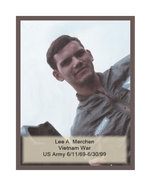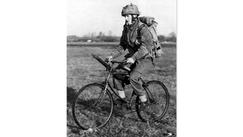 By Dick Martin War movies and books about men in combat often depict the plight of new recruits and their tendency to quickly become casualties. Combat relies on instincts that come from experience. Lee Merchen was keenly aware of this as he spent most of his tour in Vietnam, honing his skills and instincts as a helicopter pilot. As the war receded, a surplus of helicopter pilots developed and Lee was assigned to his detail branch, the artillery. He was then attached to an infantry unit as a forward observer. This new position required Lee to develop an entirely new set of skills and instincts; something that was rarely required of the troops in Vietnam.
0 Comments
 By Dick Martin In 1967, the First Marine Division had been conducting operations in the dangerous I Corp area of Vietnam. Larry Talsma was busy driving a truck through the area and Dan Mejstrik, as a medic, was busy patrolling with his platoon in the same area. On a day in November of 1967, Larry was leaving the Marine base camp at An Hoa in his truck bound for Da Nang. At the same time, a marine unit was patrolling the road out of An Hoa. Without any warning, Larry found a bearded Dan Mejstrik on his running board. Dan had spotted Larry driving by in his truck, jumped on the running board, and had a quick reunion while Larry’s truck passed Dan’s platoon.  By Dick Martin From its playful origins as a dandy horse for idle Europeans, the bicycle has taken on increasingly serious military applications and for 130 years has remained militarily relevant. In August 1887, the French Scientific journal La Nature noted favorably the role the velocipede, or bicycle, was beginning to play in European military maneuvers. Several European armies fielded bicycle-mounted units during World War I. Originally used to transport ammunition on the battlefield, the first bicycles had no pedals and had to be propelled by the wheelman’s legs. Conceived in 1817 by German Karl Drais, the earliest precursor to the modern bicycle was used as a two and four wheeled version in reconnaissance and patrols. In 1860, the French found commercial uses for the bicycle. By then, it had evolved to include pedals on the front wheel, much like a trike, inflated rubber tires and a chain drive linking central pedals to the rear wheels. Given the improvements, military planners began to consider the bicycle as an alternative conveyance to the horse. The bicycle required neither fodder nor rest and is generally easier to maintain than a horse and much quieter. By the turn of the century, the militaries of all the world’s leading powers were using the bicycle. Its first major test in combat came on the Western Front during the closing days of World War 1. Because of the initial static nature of trench warfare during that war, the bicycle’s mobility was of little use to the warring sides, except in the rear areas, where it was used as messengers or ambulance carriers. However, in the closing stages of the war, when the stalemate broke in August of 1918 during the Allied Offensive known as the “Hundred Days,” the war became much more mobile. During this period, mobility became a primary asset for the bicycle as it was used to conduct patrols, stealth transfer of messages, and rapid movement of military units about the battlefield. During WWII, the Germans took advantage of the bicycles’ fit into their military philosophy, where it became an important part of the blitzkrieg mobility. In Japan, thousands of bicycle troops were used in its 1937 invasion of China as well as relying on them in their 1942 invasion of Singapore. Across Britain, airfields used the bicycle to quickly move air crews to their waiting planes. During the Vietnam War, the bicycle was used as a key logistical resource for North Vietnam regulars moving supplies along the Ho Chi Minh Trail, the main route for bringing supplies into South Vietnam. Bicycles have been common throughout Vietnam since the early 1900s and continue to be used there for personal transportation as well as for haulage. The bicycle has played a role in irregular warfare during the far-flung wars of the 20th century. In recent decades, irregular forces in the Middle East have even weaponized the bicycle. In 2006, a successful NATO operation was marred when a suicide bomber using a bicycle killed four foot soldiers. The bicycle has also been used as a lethal weapon by the IRA in Northern Ireland. Far from fading into irrelevance during it third century as a conveyance, the bicycle continues to be an integral part of warfare. Needing neither fuel nor fodder, faster and quieter than man afoot, it will continue to find military application. Edited from an article “Wheels of War” found in the July 2020 edition of the magazine “Military History.”  By Dick Martin Harvey Kastein’s first deployment, after finishing his initial Navy school, was as a Seaman on the USS Collett ship. The deployment was highlighted on February 10, 1969, by being part of a naval gunfire support team anchored at Da Nang Harbor providing supporting fire for friendly forces inland involved in combat operations twenty miles south of Da Nang. Months later during a redeployment back to Vietnam at a stop in Okinawa, Harvey felt a tug at his sleeve and turned around to face a battle hardened Marine. Not knowing what the Marine had in mind, Harvey was startled until the Marine, having seen Harvey’s Collet patch, thanked him profusely for the fire support that February 10 that the Marine said saved their rear-ends.  By Dick Martin In putting together the Springfield Veterans Book, one of the big surprises for me, and there were many, was the respect our soldiers had for the German soldiers in the regular army (Heer). It seems like all of the atrocities were committed by Hitler’s other army, the Waffen-SS, which was made up of more radical, psychopathic, and maniacal soldiers; ie, the Waffen-SS were the soldiers responsible for the Malmedy massacre. An example of the regular army soldiers (Heer) was related to me by Chuck Dawes, who spent most of his time in Europe as a POW. He said the regular army Wehrmacht were much like American soldiers. He told me that he often thanked God for being a German-held POW and not a Jap-held POW. Chuck said that if the guards had food they shared it with the POWs and if the guards were without food, they all starved together. As Hitler began his European domination, he unleashed his two distinct armies on Europe. It is almost impossible to overstate Nazi Germany’s military achievements at the outset of World War 2. The two armies (Waffen-SS and Heer) competed with each other. Despite impressions of Hitler’s German State being one of monolithic centralized control, Hitler encouraged competition among the various state and party organs. It stood to reason, therefore, such duplication of effort would ultimately manifest itself on the battlefield. At their peaks, the terrorist leaning Waffen-SS was composed of approximately 900,000 soldiers and the regular army Heer was composed of approximately 13,600,000 soldiers. Initial membership requirements for the Waffen-SS were more exacting than those for the Heer. Potential recruits were required to prove their “Aryan” ancestry back several generations, be at least 5’ 9” tall and could be rejected for having even a single dental filling. Only one applicant in four was accepted into the elite force. Levels of political indoctrination were significantly higher in the Waffen-SS than in the Heer. Recruits of all ranks were given extensive classroom instruction in the National Socialist ideology. Political involvement was mandatory for the Waffen-SS. Every member of the Waffen-SS was required to be a member of the Nazi Party. It is no wonder that the Waffen-SS was much more fanatical than the regular army Heer. As the war widened volunteers were recruited from the populations of such allied nations as Holland, Norway, France and Russia. Perhaps the most fiercely debated aspect of the relationship between the Heer and Waffen-SS is the question of which organization was the most complicit in war crimes. The debate came up immediately after the war ended as the allies prepared for the Nuremberg war trials. The Heer would have us believe that the Waffen-SS, which was declared a criminal organization at the trials, was the more complicit. The Heer war crimes were spread out over an organization that was approximately 14 times bigger than the Waffen-SS. That the Waffen-SS did not have a monopoly on brutality throughout the war is well documented. However considering the size off the two organizations, the Waffen-SS would have to be considered the more evil of the two. Taken and edited from an article in the July 2020 Military History magazine. |
Categories
All
Archives
October 2023
|